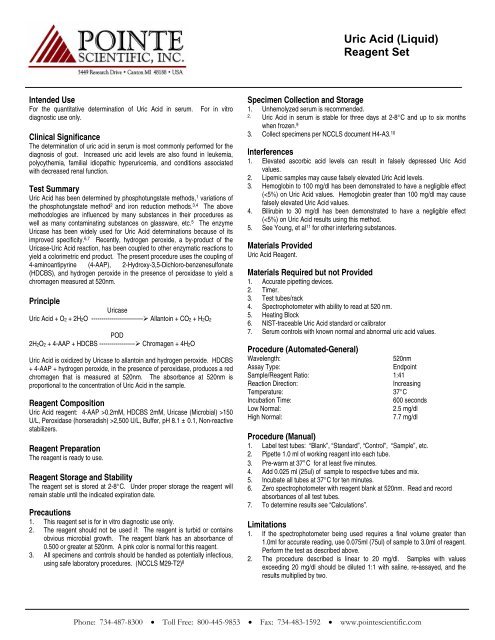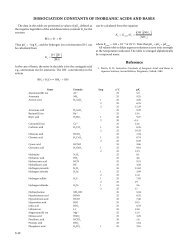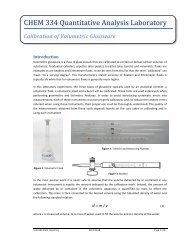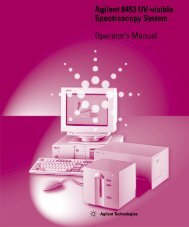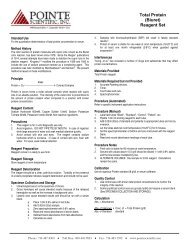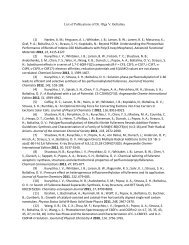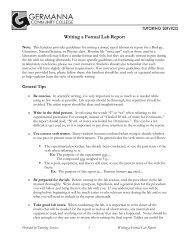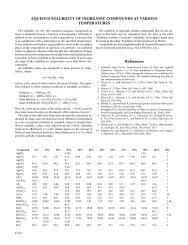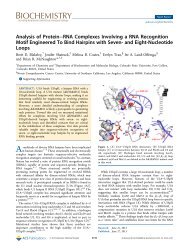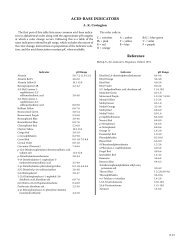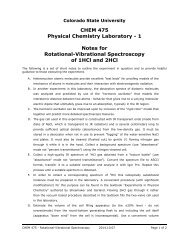Uric Acid (Liquid) Reagent Set - BrandSD
Uric Acid (Liquid) Reagent Set - BrandSD
Uric Acid (Liquid) Reagent Set - BrandSD
You also want an ePaper? Increase the reach of your titles
YUMPU automatically turns print PDFs into web optimized ePapers that Google loves.
<strong>Uric</strong> <strong>Acid</strong> (<strong>Liquid</strong>)<br />
<strong>Reagent</strong> <strong>Set</strong><br />
Intended Use<br />
For the quantitative determination of <strong>Uric</strong> <strong>Acid</strong> in serum. For in vitro<br />
diagnostic use only.<br />
Clinical Significance<br />
The determination of uric acid in serum is most commonly performed for the<br />
diagnosis of gout. Increased uric acid levels are also found in leukemia,<br />
polycythemia, familial idiopathic hyperuricemia, and conditions associated<br />
with decreased renal function.<br />
Test Summary<br />
<strong>Uric</strong> <strong>Acid</strong> has been determined by phosphotungstate methods, 1 variations of<br />
the phosphotungstate method 2 and iron reduction methods. 3,4 The above<br />
methodologies are influenced by many substances in their procedures as<br />
well as many contaminating substances on glassware, etc. 5 The enzyme<br />
<strong>Uric</strong>ase has been widely used for <strong>Uric</strong> <strong>Acid</strong> determinations because of its<br />
improved specificity. 6,7 Recently, hydrogen peroxide, a by-product of the<br />
<strong>Uric</strong>ase-<strong>Uric</strong> <strong>Acid</strong> reaction, has been coupled to other enzymatic reactions to<br />
yield a colorimetric end product. The present procedure uses the coupling of<br />
4-aminoantipyrine (4-AAP), 2-Hydroxy-3,5-Dichloro-benzenesulfonate<br />
(HDCBS), and hydrogen peroxide in the presence of peroxidase to yield a<br />
chromagen measured at 520nm.<br />
Principle<br />
<strong>Uric</strong>ase<br />
<strong>Uric</strong> <strong>Acid</strong> + O2 + 2H2O --------------------------‣ Allantoin + CO2 + H2O2<br />
POD<br />
2H2O2 + 4-AAP + HDCBS ------------------‣ Chromagen + 4H2O<br />
<strong>Uric</strong> <strong>Acid</strong> is oxidized by <strong>Uric</strong>ase to allantoin and hydrogen peroxide. HDCBS<br />
+ 4-AAP + hydrogen peroxide, in the presence of peroxidase, produces a red<br />
chromagen that is measured at 520nm. The absorbance at 520nm is<br />
proportional to the concentration of <strong>Uric</strong> <strong>Acid</strong> in the sample.<br />
<strong>Reagent</strong> Composition<br />
<strong>Uric</strong> <strong>Acid</strong> reagent: 4-AAP >0.2mM, HDCBS 2mM, <strong>Uric</strong>ase (Microbial) >150<br />
U/L, Peroxidase (horseradish) >2,500 U/L, Buffer, pH 8.1 ± 0.1, Non-reactive<br />
stabilizers.<br />
<strong>Reagent</strong> Preparation<br />
The reagent is ready to use.<br />
<strong>Reagent</strong> Storage and Stability<br />
The reagent set is stored at 2-8°C. Under proper storage the reagent will<br />
remain stable until the indicated expiration date.<br />
Precautions<br />
1. This reagent set is for in vitro diagnostic use only.<br />
2. The reagent should not be used if: The reagent is turbid or contains<br />
obvious microbial growth. The reagent blank has an absorbance of<br />
0.500 or greater at 520nm. A pink color is normal for this reagent.<br />
3. All specimens and controls should be handled as potentially infectious,<br />
using safe laboratory procedures. (NCCLS M29-T2) 8<br />
Specimen Collection and Storage<br />
1. Unhemolyzed serum is recommended.<br />
2.<br />
<strong>Uric</strong> <strong>Acid</strong> in serum is stable for three days at 2-8°C and up to six months<br />
when frozen. 9<br />
3. Collect specimens per NCCLS document H4-A3. 10<br />
Interferences<br />
1. Elevated ascorbic acid levels can result in falsely depressed <strong>Uric</strong> <strong>Acid</strong><br />
values.<br />
2. Lipemic samples may cause falsely elevated <strong>Uric</strong> <strong>Acid</strong> levels.<br />
3. Hemoglobin to 100 mg/dl has been demonstrated to have a negligible effect<br />
(
<strong>Uric</strong> <strong>Acid</strong> (<strong>Liquid</strong>)<br />
<strong>Reagent</strong> <strong>Set</strong><br />
3. Lipemic samples will give falsely elevated results and a serum blank<br />
must be run. Serum Blank: Add 0.025ml (25ul) of sample to 1.0ml<br />
water. Zero spectrophotometer with water. Read and record<br />
absorbance and subtract reading from test absorbance. Calculate as<br />
usual.<br />
Calibration<br />
Use an NIST-traceable <strong>Uric</strong> <strong>Acid</strong> standard (5.0 mg/dl) or serum calibrator.<br />
The procedure should be calibrated according to the instrument<br />
manufacturer’s calibration instructions. If control results are found to be out<br />
of range, the procedure should be re-calibrated.<br />
Calculations<br />
A = Absorbance<br />
A (Unk) x Conc. of Std (mg/dl). = <strong>Uric</strong> <strong>Acid</strong> (mg/dl)<br />
A (Std)<br />
Example: A (Unk) =0.126, A (Std) = 0.100, Conc. of Std = 5 mg/dl.<br />
Then: 0.126 x 5 = 6.3 mg/dl<br />
0.100<br />
SI Units (mM/L)<br />
To convert to mM/L, multiply the result (mg/dl) by 10 to convert dl to L and<br />
divide by 168 (the molecular weight of <strong>Uric</strong> <strong>Acid</strong>).<br />
Mg/dl x 10 = mM/L<br />
168<br />
Example: 6.3mg/dl x .0595 = 0.374mM/L<br />
mg/dl x .0595 = mM/L<br />
Quality Control<br />
Serum controls with known normal and abnormal uric acid values should be<br />
run routinely to monitor the validity of the reaction. These controls should be<br />
run at least with every working shift in which uric acid determinations are<br />
performed. It is strongly recommended that each laboratory establish their<br />
own frequency of control determination.<br />
Expected Values<br />
2.5 - 7.7mg/dl 9<br />
It is strongly recommended that each laboratory establish its own normal<br />
range.<br />
Performance<br />
1. Assay Range: 0 - 20 mg/dl<br />
2. Comparison: Results obtained with this reagent (y), in 132 samples<br />
ranging in <strong>Uric</strong> <strong>Acid</strong> from 1.9-10.5 mg/dl, were compared with those<br />
obtained in the same samples using a dry-powder reagent (x) based on<br />
the same methodology. The correlation coefficient was 0.999 and the<br />
regression equation was y=1.00x-0.02. (Sy.x=19.66).<br />
3. Precision: Precision studies were performed following the guidelines<br />
contained in NCCLS document EP5-T2. 12<br />
Within Day (n=20)<br />
Day to Day (n=20)<br />
Mean S.D. C.V.% Mean S.D. C.V.%<br />
6.0 0.06 1.0 6.1 0.16 2.63<br />
6.9 0.04 0.58 7.2 0.16 2.24<br />
9.9 0.06 0.60 10.2 0.31 3.05<br />
4. Sensitivity: The sensitivity of this reagent was investigated by reading the<br />
change in absorbance at 520nm for a saline sample, and two serum samples<br />
with known concentrations. Ten replicates of each sample were performed.<br />
The results of this investigation indicated that, on the analyzer used, the <strong>Uric</strong><br />
<strong>Acid</strong> (<strong>Liquid</strong>) reagent showed little or no reagent drift on a zero sample.<br />
Also, that an absorbance change of 0.015 was approximately equivalent to 1<br />
mg/dl of <strong>Uric</strong> <strong>Acid</strong>.<br />
References<br />
1. Folin, D., Dennis, W., J. Biol. Chem. 13:469 (1913).<br />
2. Caraway, W.T., Clin. Chem. 4:239 (1963).<br />
3. Morin, L.G., J. Clin. Path. 60:691 (1973).<br />
4. Morin, L.G., Clin. Chem. 20:51 (1974).<br />
5. Brochner-Mortenson, K., Medicine 19:161 (1940).<br />
6. Klackar, H.M., J. Biol. Chem. 167:429 (1947).<br />
7. Praetorius, E., Poulson, H., Scand. J. Clin. Invest 5:273 (1953).<br />
8. NCCLS document “Protection of Laboratory Workers form Infectious Disease<br />
Transmitted by Blood, Body Fluids, and Tissue”, 2 nd Ed. (1991).<br />
9. Henry, R.J., Clinical Chemistry: Principles and Technics, 2 nd Ed.,<br />
Hagerstown (MD), Harper & Row, pp. 531 & 541 (1974).<br />
10. NCCLS document “Procedures for the Collection of Diagnostic Blood<br />
Specimens by Skin Puncture”, 3 rd Ed. (1991).<br />
11. Young, D.S., et al. Clin. Chem. 21:1D (1975).<br />
12. NCCLS document “Evaluation of Precision Performance of Clinical<br />
Chemistry Devices”, 2 nd Ed. (1992).<br />
Manufactured by Pointe Scientific, Inc.<br />
5449 Research Drive, Canton, MI 48188<br />
European Authorized Representative:<br />
Obelis s.a.<br />
Boulevard Général Wahis 53<br />
1030 Brussels, BELGIUM<br />
Tel: (32)2.732.59.54 Fax: (32)2.732.60.03 email: mail@obelis.net<br />
Rev. 12/09 P803-U7581-01


